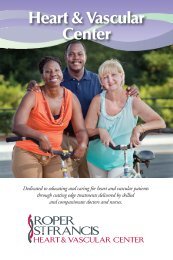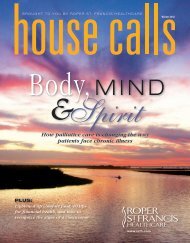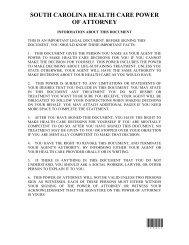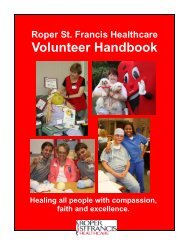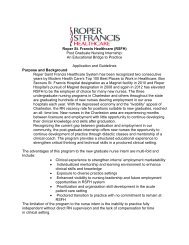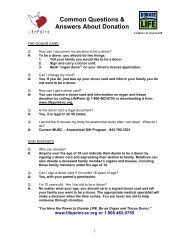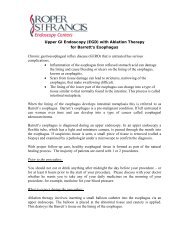Fall 2008, Boost Your Health - Roper St. Francis Healthcare
Fall 2008, Boost Your Health - Roper St. Francis Healthcare
Fall 2008, Boost Your Health - Roper St. Francis Healthcare
You also want an ePaper? Increase the reach of your titles
YUMPU automatically turns print PDFs into web optimized ePapers that Google loves.
2Spend Timewith People,not technologyREADING LISTGet your own book club talkingwith these insightful memoirsEat, Pray, Loveby Elizabeth GilbertNewly divorced, the authorsets out for a year of travel,seeking self-discovery inIndia, Italy, and Indonesia.(Penguin, 2007)The Measure of a Manby Sidney PoitierIn this best-selling book, theAcademy Award-winning actorwrites of family, relationships,and career. (Harper, 2007)Reading Lolita in Tehranby Azar NafisiSet in Tehran during therepressive 1990s, this memoirfocuses on a secret women’sliterary discussion group.(Random House, <strong>2008</strong>)Better mental and physical health is onlyan arm’s reach away—to the “off” buttonon your television or computer. Peopleare spending more time than ever staringat screens for work and leisure. In fact,researchers at the University ofCalifornia-Berkeley found thatAmericans spend nine timesas many minutes watchingtelevision as they do playingsports, exercising, and doing allother leisure-time physicalactivities combined. It is adangerous habit, says boardcertified family medicine doctorTed Dunn. “Sitting in front of thetelevision slows metabolism andcan contribute to weight gain.This added weight can helpcause type 2 diabetes, high bloodpressure, and more.”Excessive screen-watching canalso impact your emotional andpsychological health. Prolonged behaviors thatisolate you from human interaction can lead tomood swings, sadness, and even clinical depression.As an alternative, Dr. Dunn suggests spending moretime with friends, family, and acquaintances.“Seemingly minor encounters with other people canlower your pulse and bloodAmericans spendnine times asmany minuteswatchingtelevision asthey do playing sports,exercising, and doing allother leisure-time physicalactivities combined.pressure while reducing stress,”he says.When you do watch TV orwork on the computer, boardcertified family medicine doctorDaniel McMahon recommendsregular breaks for stretching,and above all, walking awayafter a reasonable amount oftime. “Challenge your mind byreading or doing crosswordpuzzles,” he urges. “Thesemental exercises may delaydementia and they certainlyimprove focus, concentration,and memory skills.”24 house calls
3Increase <strong>Your</strong>Fiber IntakeWHAT SHOULD I EAT?<strong>Boost</strong> digestive health by workingthese fiber-rich foods into your dietRaspberries1 cup = 8gfruitsPear1 medium = 5.1gApple1 medium = 4.4gCooked artichoke1 medium = 10.3gMany Americans have cometo view fiber as merely acure for constipation—something to be looked forin case of emergency. Incontrast, Dr. McMahoncounsels his patients to view fiber aspreventative medicine, a key ingredient inday-to-day health. “Fiber is critical inpreventing conditions like diverticulosisand diverticulitis, two serious illnesses thatweaken the colon.”In addition, evidence suggests thathealthy fiber intake can reduce the risk ofcolon cancer and lower cholesterol andblood sugar levels. “It’s important to practicehealthy fiber habits early in life, beforeproblems develop and supplements arenecessary,” Dr. McMahon cautions.According to the Mayo Clinic, menunder the age of 50 should seek to includeat least 38 grams of fiber in their diet eachday; women under 50 need at least 25grams. After the age of 50, men canreduce their intake to 30 grams, women to21 grams. Aside from the sources of fiberthat most are familiar with, such as branmuffins and beans, a host of fruits andvegetables can balance out a daily serving.Look for fiber in unlikely places such asraspberries, pears, and even popcorn.Men under theage of 50 shouldseek to include at least38 grams offiber in their diet eachday; womenunder 50 needat least 25grams. After theage of 50, men canreduce theirintake to 30grams, women to21 grams.vegetableslegumes, nuts, seedsgrains, cereal, pastaBroccoli1 cup = 5.1 gCooked lentils1 cup = 13.6gCooked pearled barley1 cup = 6gCooked peas1 cup = 8.8gCooked split peas1 cup = 16.3gCooked black beans1 cup = 15gCooked wholewheatpasta1 cup = 6.3gMedium oat bran muffin1 cup = 5.2ghouse calls 25
4find out if youare a Candidatefor Hip or KneeReplacement5THE LOWCOUNTRYSENIOR CENTERoffers a large lineup ofactivities ranging frombocce ball to dance andcomputer classes.To find out more,call (843) 762-9555or log on towww.rsfh.com/seniorcenterstep away fromthe soda machineThe gradual decline of a knee orhip can take place over manyyears due to osteoarthritis orother factors. As individualsslowly adjust to pain, limitedmobility, and reduced flexibility,many accept the effects as “normal” anddon’t seek the treatment that could addtremendous value to their lives.“It is estimated that fewer than 25percent of good replacement candidatesactually see a doctor to have the procedure,”says board certified orthopaedic surgeonJohn McCrosson. “Yet it’s one of the bestthings a person can do to stay mobile,active, and independent at an older age.”While total hip replacement is consideredan invasive treatment with an extendedrecovery period, researchers at DukeUniversity found that it dramaticallyincreased the quality of life for individualsup to age 80 or even 90.Dr. McCrosson recommends asking yourdoctor about an assessment and consideringthe benefits of such a procedure. “A simplequestion puts many on a path that literallychanges the rest of their lives,” he says.Learn about the services offered at the <strong>Roper</strong> <strong>St</strong>.<strong>Francis</strong> Joint Replacement Center by calling(843) 402-CARE or logging on to www.rsfh.com/joint.One 12-ouncecan of soda has asmuch as 13teaspoonsof sugar in theform of high-fructosecorn syrup.Dr. Wildstein minces no words when itcomes to America’s fizzy beverage ofchoice. “Soft drinks will be known asthe cigarettes of the future,” hecontends. Before you laugh at thecomparison, consider this: the FederalTrade Commission and the Department of <strong>Health</strong>and Human Services pressured Coca-Cola andPepsiCo to voluntarily limit how much they marketto children under the age of 12, reports theNemours Foundation. This unusual action wastaken as part of a national campaign to fight childobesity, but it may as well have been undertakenfor a dozen different reasons.A recent study found that adults who consumeone or more sodas a day carried about a 50 percenthigher chance of metabolic syndrome—a group ofrisk factors that include excessive fat around thewaist, low levels of “good” cholesterol, and highblood pressure. “Soft drinks are bad for your bonesand teeth, plus they are dehydrating and contributeto diabetes,” Dr. Wildstein explains. “People need tobe aware that they are not a substitute for water.”Dr. Wildstein recommends replacing thatlunchtime soda with water or sugar-free fruit juice.And when you do reach for water, fill your glass atthe tap instead of from a plastic bottle, addsDr. McCrosson. “City water is often tested morestringently and regularly than bottled water,” heexplains. “Also, it usually includes a fluoride additiveto help prevent cavities among children.”26 house calls
6get better restFACT OR FICTION?Test your sleep knowledge withthis quiz based on research bythe National Sleep FoundationIt’s common knowledge that most adults requireseven or eight hours of sleep per night foroptimum health. But simply being in bed forthe right number of hours doesn’t always meanyou are getting what yourbody really needs: restful,restoring sleep. “It’s amazinghow many people do thingsright before bedtime that arecounterproductive to fallingasleep and staying asleep,” saysDr. Dunn. “Alcohol, caffeine,and stress-inducing activitiesaffect the type of sleep weexperience, so that even if youfall asleep, you will not haveeffective sleep and may evenfeel worse the next morning.”According to the National Instituteof Neurological Disorders and <strong>St</strong>roke,the definition of “effective sleep” is a sustainedperiod during which the individual passesthrough the REM, or dreaming, phase into a periodSimply beingin bed for the rightnumber of hours doesn’talways mean you aregetting what your bodyreally needs: restful,restoring sleep.of dreamless, restful sleep. Unfortunately, childrenand adults alike can unknowingly impede thisimportant process, leaving them to suffer throughdays filled with drowsiness, lack of concentration,and even depression.To maximize your sleep andget more out of your wakinghours, it helps first to exerciseduring the day and then to set aregular bedtime. Find a relaxingactivity, such as reading orlistening to soothing music,and spend time doing it beforeturning off the light. Finally, besure to do something aboutsleeplessness—if you can’t fallasleep within 15 minutes, getup and engage in a relaxingactivity to reset your mind.To find out about getting an evaluation from the <strong>Roper</strong><strong>St</strong>. <strong>Francis</strong> Sleep Center, log on to www.rsfh.com/sleep orhave your doctor call (843) 723-2246.You can catch up on lostsleep over the weekend.FICTION: Sleeping moreon weekends in an attempt to“make up” for sleep lost duringthe week only disrupts yourcircadian rhythms, setting you upto have more trouble sleeping inthe days ahead.Snoring can be harmful.FACT: Snoring can be asign of sleep apnea, a conditioncharacterized by brief episodes ofreduced or no airflow at night.Some people functionfine on just four or fivehours of sleep.FICTION: Many peoplewho make such claims justaren’t aware of how tired theyare. The bottom line is, too littlesleep is bad for your health,impairing judgment, weakeningthe immune system, and leadingto weight gain.house calls 27
Slow Down7at Meal TimesA study at the University of Rhode Island inKingston recently found that by eatingslower, you can eat about 70 fewercalories per meal, which adds up to 210calories a day. This caloriereduction could help you lose two pounds permonth and 24 poundsper year.For many of us, meals are something tosqueeze in between meetings or as werush out the door. But did you know thathurrying through lunch can also meanbypassing the built-in mechanism in yourbody that tells you when you are full?According to board certified endocrinologist KimPugh, “there is a slight delay in the intricate signalingfrom the stomach to the brain. When we eat toofast, we can miss that message and continue eating,even though our stomach has had enough.”Overeating at any age can lead to obesity and thehost of problems that accompany it: diabetes, highcholesterol and blood pressure, and even sleepapnea. Children are at a particularly high risk forignoring the body’s fullness signals, especially ifthey are distracted by the television or are eating inthe car. Dr. Pugh recommends setting regularmealtimes, avoiding distractions, and even puttingutensils down between each bite. “This gives yourbrain and stomach time to communicate so that youknow when to stop.”28 house calls
8work out whilesitting stillPalm Versus PalmHold arms at chest level and press palms firmlyagainst each other. Hold for three to five seconds,breathing evenly. Repeat 15 to 20 times.Wall Squat<strong>St</strong>and against a wall with feet two feet from thewall. Keep eyes looking forward and head touchingthe wall. Inhale, and as you exhale, bend knees toslide your back down the wall as far as you feelcomfortable. Hold for five to 10 seconds, breathingevenly. Move slowly back to start position.a. b.Neck Extension & Flexiona. Lace your fingers together behind your head.Push your head backwards against the resistanceof your palms for five seconds, breathing evenly,then relax. Repeat 10 to 15 times. b. Hold yourforehead in the palm of your hand. Push yourhead against the resistance of your hand for fiveseconds, then relax. Repeat 10 to 15 times.ILLUSTRATIONS BY COURTNEY FRAYLICKAs gyms overflow with more (and morecomplicated) workout machines thanever before, it’s easy to feel like gettingin shape must require some kindof equipment. Not so, arguesDr. McCrosson: “you can do isometricexercises anywhere, anytime. You don’t needequipment, and it’s easier on joints than traditionalweightlifting.”Isometric exercises harness your own body’sresistance to work your muscles without movingany joints. This is most often accomplished byholding the body in place (for example, laying onthe floor and holding your legs up at a slightangle) or against itself (such as by pressing yourpalms against each other). When the muscleswork, they demand more blood and oxygen,which helps lower high blood pressure, increasetone, and build stamina, all while puttingminimal stress on your joints.“Reducing joint stress is important for everyone,but especially seniors or those recovering frominjury or surgery,” Dr. McCrosson explains. “It’s agood idea to see a physical therapist or speakwith a doctor before undertaking an isometricexercise regimen.”house calls 29
By Dennis QuickIllustration by Thomas NowackiOn theRISEThe prevention and treatment of high blood pressurePART 3 OF A SPECIAL 3-PART SERIESTo read the first two installmentsin this series, log on towww.rsfh.com/newscenter.Ahouse calls 31
PART 3: PREVENTION & TREATMENTPreventing PrimaryHypertensionYou’ll recall that primary hypertension, whichaccounts for 90 to 95 percent of high bloodpressure cases, develops due to a combinationof factors—many which you can control.“Lifestyle choices such as maintaining a healthyweight, nutritious diet, and regular exercise habitscan prevent or delay this condition and will also benecessary to treat hypertension that has alreadydeveloped,” says <strong>St</strong>ephen Busby, MD, a Johns Islandfamily medicine doctor affiliated with <strong>Roper</strong> <strong>St</strong>.<strong>Francis</strong> <strong>Health</strong>care. Here, we’ll detail several of themost important steps that you can take to keep yourblood pressure healthy. EXERCISE REGULARLY. According to the AmericanHeart Association, less active people are 30 to 50percent more likely to develop hypertension. “Irecommend that my patients get 30 minutes of aerobicexercise every day,” says Dr. Busby. Althoughflexibility and strength training are important for overallhealth, aerobic activities—those that increase yourheart and breathing rates—are the ones mostimportant for controlling blood pressure. If you don’thave time for a daily swim or jog, make householdchores count by scrubbing the tub with extra vigor orpicking up the pace as you mow the lawn. FOLLOW A HEALTHY EATING PLAN. The AmericanHeart Association recommends a diet rich in fruits,vegetables, and whole-grain, high-fiber foods, as wellas low-fat dairy products, legumes, lean meats, andpoultry. Aim to eat two servings of fish a week,especially those such as salmon and albacore tuna thatare high in omega-3 fatty acids. Aren’t sure whetheryour eating habits qualify as healthy? Keep a food diaryfor at least a week, writing down what you eat, howmuch, when, and why. Once you’re finished, analyzeit closely, referencing a personalized food pyramidsuch as those found at www.mypyramid.gov. CUT BACK ON SODIUM. One of the most importantthings you can do for your blood pressure is reduceyour sodium intake, says Dr. Busby. The DietaryGuidelines for Americans recommend that adultsconsume less than 2,400 milligrams of sodium eachday—that’s about six grams or one teaspoon of tableThe Dietary Guidelines for Americans recommendthat adults consume less than 2,400 milligrams ofsodium each day—that’s about six grams or oneteaspoon of table salt.salt. “However, about half of people are ‘sodiumsensitive,’ meaning that sodium has an even greatereffect on their blood pressure,” says Dr. Busby. “Thisgroup of people, who should consume less than 1,500milligrams a day, often includes African Americans,people over age 50, and those with chronic conditionslike heart disease, kidney disease, or diabetes.”Keep sodium levels in check by reading yournutrition labels—even “health” foods like vegetablejuices can have high amounts—and seasoning withherbs and spices instead of salt. Also aim to get 3,500milligrams a day of potassium, a mineral found infruits and vegetables that helps balance the sodiumin your cells. SHED EXCESS FAT. “To prevent hypertension orlower blood pressure, the most important thing anoverweight person can do is slim down,” advises Dr.Busby. Because “belly fat” is particularly detrimental toblood pressure, men should generally aim to keeptheir waistlines at 40 inches or less while womenshould shoot for 35 inches or less.If you’ve been sedentary for years, you’ll likelyexperience lowered blood pressure within weeksof getting active. STAY AWAY FROM TOBACCO PRODUCTS. If you usetobacco frequently, you could be damaging yourarteries and causing blood pressure to remain highthroughout the day. KEEP STRESS IN CHECK. To protect your blood vesselsfrom the cumulative effects of too much stress,try to identify any sources of anxiety and then determinehealthy ways to cope with them. Physical activityis a great stress-buster, while deep-breathing exercises,meditation, and more sleep can also be verybeneficial. LIMIT ALCOHOL INTAKE. Dr. Busby recommendssticking to amounts considered moderate: two drinksa day for men under age 65 and one a day for men65 or older and women of all ages.Preventing SecondaryHypertensionSecondary hypertension is a bit harder to ward off,as it is often caused by an underlying condition suchas kidney or heart disease. However, Dr. Busbynotes, “A healthy lifestyle can help you avoid someof these ailments.” Weight loss, for instance, canprevent or reduce your risk of sleep apnea, whilereducing alcohol intake lessens your chance of32 house calls
Written by Michelle Greenewhat aBellyache!Learning how toread common stomachsymptoms can help youfind both short- andlong-term reliefIt’s a familiar complaint from young and old alike: “My stomach hurts!”Whether you’re a parent trying to figure out what’s wrong with your littleone or you are experiencing inner grumblings of your own, it’s often hardto know what exactly is wrong, much less whether it warrants medication,a trip to the bathroom, or an emergency room visit.Confusion over bellyaches is well warranted, says J. David Bohler, MD, agastrointestinologist affiliated with <strong>Roper</strong> <strong>St</strong>. <strong>Francis</strong> <strong>Health</strong>care, adding that thefirst step is to determine if the pain is in the upper or lower part of the abdomen.Because the stomach is located between the esophagus and the small intestine,your pain could be esophageal (in the tube that runs from throat to stomach),gastric (in the stomach), or digestive (in the intestines). “Talking to the patientto find out where the pain is, what kind of pain it is, what seems to trigger it,and what seems to alleviate it, is critical to making a diagnosis,” Dr. Bohler says.While you should always see a doctor about severe pain, answering thesequestions can help pinpoint the problem. Here, we’ll cover four frequentstomach-related complaints and their most common causes.house calls 35
However, when diarrhea has a sudden onset after eating andis accompanied by nausea and/or vomiting, abdominal pain, andfever, food poisoning is the likely suspect, says Dr. Bohler.“Cases can range from mild bouts that run their course to severeillness that requires hospitalization.”Regardless of its cause, be sure to drink plenty of clear fluidswhile suffering from diarrhea, as it can quickly lead todehydration. See a doctor if problems last more than three daysfor adults or two days for children—you could have irritablebowel syndrome (IBS) or inflammatory bowel disease (IBD),warns Dr. Bohler.Finally, there are those times when your stomach simply hurts.If it’s sharp pain or cramps, you probably have gas. Gas getsinto the digestive tract when you swallow air and when yourbody breaks down certain foods, particularly those that containlactose and fructose, starches like potatoes and pasta, and foodshigh in fiber such as oat bran and (surprise!) beans. If enoughgas can’t escape from the intestine, it begins to cause pain.Moving from one part of the abdomen to another, thisdiscomfort can be intense, but often abates in short order.Again, make efforts to pinpoint your trigger foods. Whileeliminating high-fat fare is always a good idea, don’t cut back onhealthy items like fruits and vegetables. Instead, you might trytaking enzymes that help your body digest carbohydrates, oreating more slowly and avoiding chewing gum to reduce theamount of air you swallow. Excessive gas problems can besymptomatic of disorders such as IBS and IBD, so see a doctor ifyou have abdominal pain for a week or longer.When sizing up your bellyache for a probable cause, keepin mind that the severity of the pain does not necessarilyindicate the severity of the problem. Gas, for example, can beexcruciating, while early colon cancer can cause little discomfortat all. Serious illnesses like appendicitis, pancreatitis, and kidneystones are generally accompanied by other symptoms such asnausea and vomiting—see our sidebar for information on whento see a doctor. “The best way to avoid stomach troubles isultimately to pay close attention to your body,” says Dr. Bohler.“Often, healthy eating habits and an awareness of which foods‘don’t agree’ with you can prevent a lot of pain.”When sizing up your bellyachefor a probable cause, keep in mind thatthat the severity of the paindoes not necessarily indicate theseverity of the problem.WHAT IS IRRITABLEBOWEL SYNDROME?Dr. Bohler says that about 20percent of his patients have thecollection of symptoms known asirritable bowel syndrome (IBS):pain, bloating, and chronicconstipation or diarrhea, or a mixof the two at different times. IBSis a disorder of the large intestinethat is generally diagnosed onlyafter other illnesses have beenruled out.In addition to having moresensitive stomachs, Dr. Bohleroften tells these patients thattheir brains simply pay too muchattention to their intestinal tracts.To improve the symptoms, hetypically prescribes an anti-spasmmedication and recommendsreducing stress levels, increasingfiber intake, and maintainingregular sleeping patterns.FEEL BETTER! A few preventative measures can help your digestive system work more smoothly* For additionalsources of fiber, see“8 Easy Ways toImprove <strong>Your</strong> <strong>Health</strong>”on page 22.Keep a food diaryWriting down what you eat canhelp you pinpoint foods that maybe triggering problems.Get your fiberFiber ensures that bowelmovements are regular,helping to prevent constipationas well as more seriousdigestive problems.<strong>St</strong>ay hydratedDrinking six toeight glasses ofwater a day aidsin digestion.Practice food safetyAvoid foodborne illnesses bycarefully washing hands aswell as all cookware andcutlery involved in food prep.house calls 37
specials boardRECIPES & FOOD STYLING BY HEATHER GARVINPHOTOGRAPHS BY TERRY KUZNIARSandwich SensationsBetween picnics and camping trips, football games and back-to-school lunches, sandwiches tend to headlineautumn menus on a regular basis. This season, think beyond the tired turkey and swiss. We layered lean meats,flavorful spreads, and in-season fruits and vegetables inside a variety of breads to create four new recipes yourlunchmates will be begging to share.Portobello & Hummus<strong>St</strong>uffed Pita(Makes 4 sandwiches)1 recipe hummus4 large portobello capsOlive oil, for drizzlingBalsamic vinegar, for drizzlingSalt and pepper to taste2 (2 oz.) whole-wheat pocket pitas1 cups baby spinach1 Roma tomato, slicedAlfalfa sprouts (optional)For hummus:2 cups canned garbanzo beans, drained3 Tbsp. lemon juice2 Tbsp. tahini2 garlic cloves, peeled1/4 tsp. saltDash of cayenne pepper1/4 cup olive or vegetable oilNutrition Pointer:Leftover hummus isperfect as a dip forvegetable crudites or as aspread on other sandwichesin place of mayonnaise.Prepare the hummus by pulsing all ingredients except forthe oil in a food processor until coarsely chopped. With themachine running, slowly stream in the oil and process untilsmooth. Hummus can be made up to five days in advance.Heat a skillet over medium-high heat. Wipe portobellocaps clean with a dry cloth and sprinkle lightly with oliveoil, balsamic vinegar, salt, and pepper. Cook each capuntil tender and juicy, about two minutes per side.Remove from heat and thinly slice. Portobellos can beprepared up to a day in advance.Assemble the sandwiches by first halving each pita. Foreach sandwich, spread about one tablespoon of hummusinside the bottom edge of the pita. (Reserve any leftoverhummus for another use.) Layer spinach leaves and tomatoover top, followed by sliced portobello and alfalfa sprouts, ifdesired, distributing evenly among the pita halves.Nutrition Facts: Serving Size: 1/2 pita; Calories: 175;Total Fat: 10.5g; Saturated Fat: 1g; Trans Fat: 0g;Cholesterol: 0mg; Sodium: 200mg; Total Carbohydrate:18g; Dietary Fiber: 4g; Sugars: 3g; Protein: 5ghouse calls 43
specials boardNutrition Pointer:A substitute for granulatedsugar, agave nectar is a lowcalorienatural sweetener youcan use in sauces, dressings,or even coffee. It has asweeter taste, so adjustaccordingly.Roasted Pork LoinSandwich with SweetPepper Relish(Makes 4 sandwiches)Approximately 12 oz. pork loin, trimmed1 recipe relish4 whole-wheat hoagie rolls4-8 pieces romaine lettuce4 oz. (4 slices) reduced-fat Swiss cheeseFor relish:1 1 /2 lbs. assorted sweet and/or bell peppers1 small jalapeño pepper1 small yellow onion1 garlic clove1/2 tsp. salt1 1 /3 cups agave nectar1 1 /4 cups cider vinegarPreheat oven to 375ºF. Sprinkle pork loin withsalt and pepper. Cook until desired doneness,about 45 minutes for well done (or untilthermometer inserted registers 165ºF). Allowpork to cool slightly before slicing. Loin can beroasted a day in advance.Make the relish by mincing the peppers, onion,garlic, and salt in a food processor. Transfer to alarge saucepan and add the nectar and vinegar.Cook over medium heat for 30 to 40 minutes,stirring occasionally, until most of the liquid hasreduced and the relish reaches jam consistency.Refrigerated relish will last for up to two weeks.To assemble the sandwiches, spread desiredamount of pepper relish on either side ofhoagie roll. Layer with lettuce, cheese, andsliced pork loin.Nutrition Facts: Serving Size: 1 sandwich;Calories: 540; Total Fat: 17g; Saturated Fat: 7g;Trans Fat: 0g; Cholesterol: 60mg; Sodium: 845mg;Total Carbohydrate: 66g; Dietary Fiber: 7g;Sugars: 23g; Protein: 33g




